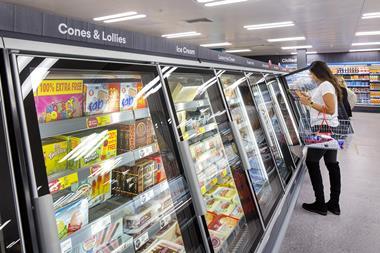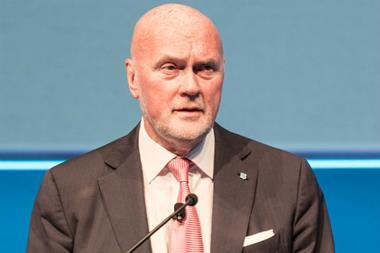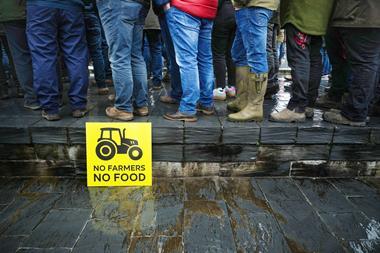Those at the sharp end deliver their verdict to Elaine Watson
Sir Ken Morrison’s post-acquisition honeymoon period came to an abrupt end last week as attempts to arrest Safeway’s plummeting sales forced the Bradford-based retailer to issue its first ever profit warning.
Not only would full-year earnings fall substantially below expectations, revealed Sir Ken, but difficulties in integrating Safeway’s new accounting system would delay the publication of Morrisons’ interim results by a month.
Last but not least, Morrisons would not benefit from £180m up front from Safeway suppliers in its interim figures, as it preferred to collect rebates at the end of the year.
Judging by Morrisons’ share price, which has not recovered since its chairman dropped the bombshell, the City is not going to forgive him in a hurry.
Yet suppliers we spoke to remained remarkably confident in his ability to deliver.
What analysts and investors have tended to forget is just how bad things actually were at Safeway before Morrisons took over, says one leading own label supplier.
“People don’t realise how much Safeway’s figures were bolstered by up-front payments from suppliers and by pushing up retail prices at the year-end.
“People are kidding themselves if they think that Safeway stores would be doing better if Morrisons simply left them alone until refurbishing them. Customers were leaving in droves.”
Likewise, news that Morrisons is replacing the Safeway approach of securing up-front cash from suppliers with its own system of retrospective overriders collected at the end of a quarter or year can only be good news, he adds. “At least then it’s not money for nothing. There is nothing worse than being beaten up by a retailer that cannot deliver.”
The fact that value sales have declined sharply at Safeway in recent weeks does not necessarily mean that Morrisons will never be able to drive volumes sufficiently to compensate for swingeing price cuts, adds a branded supplier. “These things take time, and they haven’t cut prices on all the ambient ranges yet. I also think that in some cases, they have discontinued certain lines [from Safeway] and the new [Morrisons own label] stuff hasn’t come in yet. In other words, they are not getting stock.”
Many suppliers we spoke to were also impressed with the speed at which Morrisons has got to grips with rationalising ranges, harmonising terms and getting its own label into Safeway stores.
Given that all this has been executed in conjunction with a national advertising campaign, a Morrisons label in store is not going to send Safeway shoppers into a blind panic, points out one analyst. “People know why Morrisons products are going into Safeway. They tell you as soon as you walk through the front door or switch on the TV.”
Morrisons has also moved quickly on harmonising own label ranges, taking on Safeway’s The Best premium brand as we predicted last year (December 20, p32) and subsuming its Better for You range under Safeway’s sexier Eat Smart moniker.
Impressive though all this is, the question worrying the City is whether investors will have to wait until Morrisons actually puts its own name over the front door before customers really start enjoying the change.
As one analyst observes. “They might have cut prices and they are gradually putting in some Morrisons lines, but in every other respect, they are just Safeway stores without the flyers. It feels like Safeway has fallen off the mental shopping map somehow. The stores are in no-man’s land.”
Doing nothing until the refurbishment teams arrived was not an option, however, insisted Sir Ken Morrison in a post profit-warning conference call. “Safeway had 25% of its business in loss-leaders and 75% in high priced lines. It was high-low and it was running out of steam. Wednesday had become their busiest trading day, but people were going elsewhere at the weekend for a full shop,” he said.
Dismal though Safeway sales might have been lately, the tide was beginning to turn, he claimed. Customer numbers, which had plummeted from 10.5 million a week last year to nine million in March, were back up at the 10 million level.
Like-for-like sales had moved from -13.8% in the five weeks to May 16 to -6.9% in the five weeks to June 20.
Serious challenges lie ahead. As one source close to the company observes, the cultural problems of integrating two completely different businesses are immense. Indeed, relations between Morrisons staff camped out at hotels in Middlesex and the few staff still at Safeway’s “ghost ship” Hayes HQ are understood to have become strained.
Morale at many Safeway stores also remains low, despite the improved pay and conditions. He adds: “Calling it a property deal, as Sir Ken did last week, may not have been sensible. He has still got to trade from those stores before they are converted.”
Managing the integration of two very disparate supply chains will also be tough without former Safeway logistics supremo Lawrence Christensen on board to help, he adds. “It was a shame they couldn’t offer him something to make it worth his while. My only fear is that Morrisons has such a clear way of doing things that it could dismiss Safeway’s expertise in areas like IT and supply chain too quickly.
“Just because its systems work well for its own estate doesn’t mean it should necessarily rip out everything from Safeway. It may be throwing out the baby with the bathwater.”
1. Disposals
Of the original 52 Safeway stores that Morrisons was told to divest by the Competition Commission, five are still being dealt with. Waitrose picked up 14, Sainsbury bought 14, and 19 are being sold. Morrisons has also sent out information packs on 120 of Safeway’s 138 small stores.
2. Store conversions
Four trial converted stores have exceeded expectations, with sales uplifts at 35% post-conversion against targets of 21%. The main store conversion programme starts in August, proceeding at the rate of three per week.
3. Pricing and ranging
More than £70m was pumped into 12,000 price cuts between March 8 and June 28. Ranging and pricing across the combined Morrisons/Safeway estate should be harmonised by autumn.
Morrisons has moved quickly on harmonising own label ranges, taking on Safeway’s The Best premium brand and subsuming its Better for You range under Safeway’s Eat Smart moniker.
However, an estimated £10m in unsold non-food stock that was clogging up Safeway warehouses was an unwelcome discovery.
4. Supply chain overhaul
Changes are already afoot at Safeway’s Northampton depot and Morrisons’ own-label lines have been going into Safeway stores since March. The conversion of two Morrisons RDCs and five Safeway RDCs to handle a common product range is expected to take 15 months. However, details of the IT and supply chain systems Morrisons will use have not been released.
5. Head office
Almost 1,000 Safeway staff are understood to have left Safeway’s HQ at Hayes, while buyers are already sniffing around the property. A BAA spokesman says: “We are aware the site is on the market and are in the early stages of appraising it.”
6. Fresh food expansion
Morrisons has acquired the first of up to four new packhouses with last month’s purchase of a 14-acre site in Thrapston, Northamptonshire. This will be used to pack produce for distribution to stores in the south of England. A second fresh food factory and two extra abattoirs are also in the pipeline.
Sir Ken Morrison’s post-acquisition honeymoon period came to an abrupt end last week as attempts to arrest Safeway’s plummeting sales forced the Bradford-based retailer to issue its first ever profit warning.
Not only would full-year earnings fall substantially below expectations, revealed Sir Ken, but difficulties in integrating Safeway’s new accounting system would delay the publication of Morrisons’ interim results by a month.
Last but not least, Morrisons would not benefit from £180m up front from Safeway suppliers in its interim figures, as it preferred to collect rebates at the end of the year.
Judging by Morrisons’ share price, which has not recovered since its chairman dropped the bombshell, the City is not going to forgive him in a hurry.
Yet suppliers we spoke to remained remarkably confident in his ability to deliver.
What analysts and investors have tended to forget is just how bad things actually were at Safeway before Morrisons took over, says one leading own label supplier.
“People don’t realise how much Safeway’s figures were bolstered by up-front payments from suppliers and by pushing up retail prices at the year-end.
“People are kidding themselves if they think that Safeway stores would be doing better if Morrisons simply left them alone until refurbishing them. Customers were leaving in droves.”
Likewise, news that Morrisons is replacing the Safeway approach of securing up-front cash from suppliers with its own system of retrospective overriders collected at the end of a quarter or year can only be good news, he adds. “At least then it’s not money for nothing. There is nothing worse than being beaten up by a retailer that cannot deliver.”
The fact that value sales have declined sharply at Safeway in recent weeks does not necessarily mean that Morrisons will never be able to drive volumes sufficiently to compensate for swingeing price cuts, adds a branded supplier. “These things take time, and they haven’t cut prices on all the ambient ranges yet. I also think that in some cases, they have discontinued certain lines [from Safeway] and the new [Morrisons own label] stuff hasn’t come in yet. In other words, they are not getting stock.”
Many suppliers we spoke to were also impressed with the speed at which Morrisons has got to grips with rationalising ranges, harmonising terms and getting its own label into Safeway stores.
Given that all this has been executed in conjunction with a national advertising campaign, a Morrisons label in store is not going to send Safeway shoppers into a blind panic, points out one analyst. “People know why Morrisons products are going into Safeway. They tell you as soon as you walk through the front door or switch on the TV.”
Morrisons has also moved quickly on harmonising own label ranges, taking on Safeway’s The Best premium brand as we predicted last year (December 20, p32) and subsuming its Better for You range under Safeway’s sexier Eat Smart moniker.
Impressive though all this is, the question worrying the City is whether investors will have to wait until Morrisons actually puts its own name over the front door before customers really start enjoying the change.
As one analyst observes. “They might have cut prices and they are gradually putting in some Morrisons lines, but in every other respect, they are just Safeway stores without the flyers. It feels like Safeway has fallen off the mental shopping map somehow. The stores are in no-man’s land.”
Doing nothing until the refurbishment teams arrived was not an option, however, insisted Sir Ken Morrison in a post profit-warning conference call. “Safeway had 25% of its business in loss-leaders and 75% in high priced lines. It was high-low and it was running out of steam. Wednesday had become their busiest trading day, but people were going elsewhere at the weekend for a full shop,” he said.
Dismal though Safeway sales might have been lately, the tide was beginning to turn, he claimed. Customer numbers, which had plummeted from 10.5 million a week last year to nine million in March, were back up at the 10 million level.
Like-for-like sales had moved from -13.8% in the five weeks to May 16 to -6.9% in the five weeks to June 20.
Serious challenges lie ahead. As one source close to the company observes, the cultural problems of integrating two completely different businesses are immense. Indeed, relations between Morrisons staff camped out at hotels in Middlesex and the few staff still at Safeway’s “ghost ship” Hayes HQ are understood to have become strained.
Morale at many Safeway stores also remains low, despite the improved pay and conditions. He adds: “Calling it a property deal, as Sir Ken did last week, may not have been sensible. He has still got to trade from those stores before they are converted.”
Managing the integration of two very disparate supply chains will also be tough without former Safeway logistics supremo Lawrence Christensen on board to help, he adds. “It was a shame they couldn’t offer him something to make it worth his while. My only fear is that Morrisons has such a clear way of doing things that it could dismiss Safeway’s expertise in areas like IT and supply chain too quickly.
“Just because its systems work well for its own estate doesn’t mean it should necessarily rip out everything from Safeway. It may be throwing out the baby with the bathwater.”
1. Disposals
Of the original 52 Safeway stores that Morrisons was told to divest by the Competition Commission, five are still being dealt with. Waitrose picked up 14, Sainsbury bought 14, and 19 are being sold. Morrisons has also sent out information packs on 120 of Safeway’s 138 small stores.
2. Store conversions
Four trial converted stores have exceeded expectations, with sales uplifts at 35% post-conversion against targets of 21%. The main store conversion programme starts in August, proceeding at the rate of three per week.
3. Pricing and ranging
More than £70m was pumped into 12,000 price cuts between March 8 and June 28. Ranging and pricing across the combined Morrisons/Safeway estate should be harmonised by autumn.
Morrisons has moved quickly on harmonising own label ranges, taking on Safeway’s The Best premium brand and subsuming its Better for You range under Safeway’s Eat Smart moniker.
However, an estimated £10m in unsold non-food stock that was clogging up Safeway warehouses was an unwelcome discovery.
4. Supply chain overhaul
Changes are already afoot at Safeway’s Northampton depot and Morrisons’ own-label lines have been going into Safeway stores since March. The conversion of two Morrisons RDCs and five Safeway RDCs to handle a common product range is expected to take 15 months. However, details of the IT and supply chain systems Morrisons will use have not been released.
5. Head office
Almost 1,000 Safeway staff are understood to have left Safeway’s HQ at Hayes, while buyers are already sniffing around the property. A BAA spokesman says: “We are aware the site is on the market and are in the early stages of appraising it.”
6. Fresh food expansion
Morrisons has acquired the first of up to four new packhouses with last month’s purchase of a 14-acre site in Thrapston, Northamptonshire. This will be used to pack produce for distribution to stores in the south of England. A second fresh food factory and two extra abattoirs are also in the pipeline.


















No comments yet